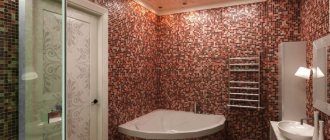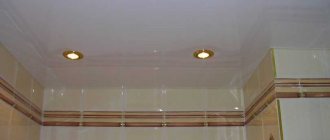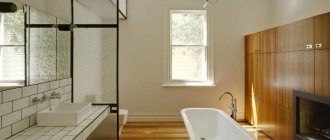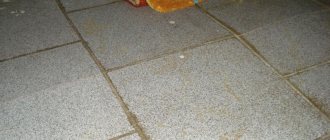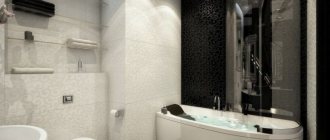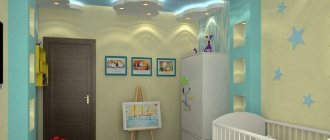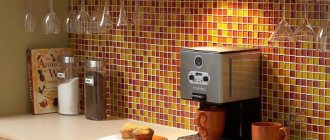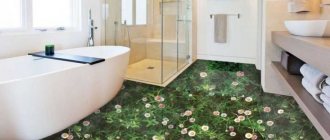Features of finishing a bathroom with mosaics
A few specific nuances:
- To decorate a small bathroom in an apartment, small glossy mosaics in light colors are suitable.
- Also, a small room can be visually expanded with the help of a mosaic border of a contrasting shade, located not high from the floor.
- Decorating with mosaics around the mirror will not only give this product an aesthetic appearance, but will also protect it from water getting inside.
- With the help of this design, it is possible to perform zoning, for example, to separate the shower room from the bathroom.
Do you like mosaics in the bathroom?
Not really
Choice of color, styling and decor
Let's look at some interesting solutions:
- Using the same shades. The effect is achieved if all surfaces are made using the predominant color. There are no contrasting inserts, but there is a background close to the main one.
- Contrasts. The opposite scheme. There are contrasting splashes against the background of a single color. The combination of tones can be different: black with white, red with white, gray with yellow, yellow with blue. The main factor is the combination of shades with each other. To avoid mistakes, it is recommended to use Itten’s color wheel or take one of the universal colors as a basis.
- The variety of mosaics allows you to recreate not only geometric shapes and compositions, but also full-fledged designs.
Color combination of mosaic for the bathroom Source happymodern.ru Color combination of mosaic Source 2gis.com
Combination of mosaic shades in the bathroom Source vplate.ru An original, but not practical method of interior decoration Source mosaic-kafel.rf
Advice! An original solution would be a mosaic panel on one of the walls of the bathroom. The project is carried out by selecting pixels of different shades.
Kinds
It is presented on the market in different colors and quality shades; it can be used to create any ornaments and decor. A comparison of mosaic types and the advantages of each of them is given in the table below.
| Selection criterion | Proposed options and their advantages | |||
| Form | Square (the most common elements, traditional version) | Rectangular (traditional design) | Round (allows you to create smooth lines and beautiful transitions) | Multifaceted (the ability to create unusual compositions) |
| Material of manufacture | Ceramics (easy to care for, variety of shades, low price) | Natural stone (a symbol of luxury, a rich palette of natural shades) | Glass (creates a 3D effect, does not require special care) | Natural wood (rich palette of shades, durable material) |
| By base type | Mesh (the mosaic is easy to cut, the elements are arranged in a certain order, suitable for installation on any surface) | Paper (ease of installation, quick and accurate laying of tiles, elements are easily fixed) | Without a base (used to create beautiful panels, installation requires certain skills) | |
| Bathroom design combinations | Single color (suitable for spacious bathrooms, the tiles have the same shape and size, use them to create a bright color accent) | Background (use white or a color close to it as a background, bright shades as an addition) | Gradient (a smooth transition from one shade to another, allows you to visually expand the room and raise the ceiling) | Mix (it is better to use contrasting shades) |
Glass
An excellent option for decorating a bathroom would be glass mosaic tiles, which allow you to create a 3D effect in the room and literally bring it to life.
The main advantages of glass tiles are their availability, relatively low price and ease of maintenance.
Glass tiles simply need to be wiped with a damp cloth and detergent.
To decorate your bathroom, choose glossy or matte tiles.
Main advantages of glass tiles:
- Presentable appearance.
- A large number of textures and shades.
- The likelihood of bacteria growing on the surface is zero.
- Temperature resistant.
- Anti-slip properties.
- Suitable not only for wall cladding, but also for floors.
Ceramic
Ceramic mosaic tiles for the bathroom are inexpensive; they are easy to cover walls with, even without the proper experience.
Ceramic tiles have water-repellent properties, it is possible to choose almost any color and pattern, but they are not suitable for finishing the floor - the material is very slippery.
Metal
Base – brass, stainless steel. The main advantages of such a mosaic are strength, resistance to temperature and mechanical damage. Suitable for tiling walls and floors, however, it can look very rough, so it should only be used in a specific bathroom interior design with mosaic tiles, skillfully combined with furniture and ceilings.
Stone and pebble
It is made from different types of stone, from pebbles to marble and granite. Stone mosaic adds rigor and richness to the interior, making it presentable. At the same time, the stone has good performance characteristics: it is durable, resistant to various types of influences, including temperature.
To make the stone look attractive, it is subjected to special processing, polished, and some areas are made “softer.” Stone does not like chemicals; wiping it with detergents is not recommended.
Use ordinary soapy water. These tiles are suitable for tiling rooms with high humidity and will be an ideal option for a kitchen or bathroom.
It is quite expensive, but at the same time, the option adds the natural shine of natural stone to the interior.
We also recommend watching - Characteristics and design of marble tiles for the bathroom
Advantages of combining mosaics with tiles
It would seem, why add another finishing material to the bathroom besides ceramics? Why can’t all the walls and floors be decorated with tiles only, since this is the most practical material? Of course you can, but the combination of tiles and mosaics has several advantages:
Firstly, mosaic is one of the “flexible” materials, in the truest sense of the word. It can be used to cover complex shapes, shaped niches and sink countertops. It is also better to decorate the space under a semicircular bathtub with a plastic material, and mosaic is ideal for this.
Secondly, if there are many complex ledges in the room for taking water procedures, then tiling them is much more difficult: labor and material costs will increase, because the tiles will need to be cut, and there will be more waste.
Thirdly, with mosaics you can adjust the design by adding a vertical or horizontal frieze where necessary. Also, do not forget that from small pixel modules you can create any design or pattern you want, complementing the main tile. This material can also be used for zoning a room.
Well, as for the resistance of mosaic elements to chemical attack and high levels of moisture, most are not inferior to good ceramic tiles. Even the mosaic can withstand temperatures from minus to
Another advantage of mosaics is the variety of materials from which mosaic elements are made: glass, ceramics, acrylic, metal, natural stone, wood.
Mosaics are laid in the same way as tiles - they are glued to most substrates (concrete, plaster, drywall, wood, foam blocks, metal).
In a word, mosaic tiles have no less advantages than ceramics, but there are features inherent only to this type of finishing material.
Flaws
However, any building or finishing material has not only advantages, but also disadvantages. In our case, this is the financial side of the issue. This applies both to the material itself and to the work involved in its installation. You will also need more grout in the area where the mosaic is installed.
But, on the other hand, high-quality work and materials that will serve for many years and will please the eye are a profitable investment. After all, after all, we start the day in the bathroom and end it right there.
Mosaic shape
Common form options:
- Round. It becomes a bright accent of the entire interior and, thanks to its high decorative qualities, harmoniously complements other elements, giving the space extraordinary beauty.
- Honeycomb (hexagon). Hexagons allow you to create unique imaginary patterns and thereby give the interior an individual character.
- Square. It is the most common and classic form, most often used in decorating bathrooms.
- Rectangular. A fairly familiar option, distinguished by its versatility.
- Diamond-shaped. This geometric diamond shape will undoubtedly become a very stylish interior solution.
- Curly. Fantasy figured fragments of different shapes and sizes represent an extraordinary design approach that allows you to enrich the visual image of the room.
Due to a certain shape, you can create a truly spectacular and unusual decor, which will undoubtedly become the brightest and most eye-catching element of the entire design.
Materials
Mosaic tiles for the bathroom can be made from a variety of materials. When choosing it, you need to focus on the following parameters:
- Selected bathroom style.
- Price.
- Quality.
- Variability of color solutions.
Each of these points needs to be given special attention. The tiles can be decorated with bright colors and look great, but their technical characteristics and durability will be minimal. In order not to have to do repairs every year, you need to choose the right tiles once.
Mirror
Mirror tiles for bathroom cladding can be installed not only on the walls, but also on the floor and ceiling.
It is recommended to decorate only one surface in this way so that the bathroom does not turn into something incomprehensible and can perform its main functions.
The main advantages of mirror mosaic tiles:
- Environmentally friendly and safe material, does not cause harm to human health.
- It is made of ceramics, porcelain stoneware, which makes it durable and difficult to break.
- Resistant to temperatures and chemicals, does not require special care.
- Durability and practicality.
- Visual expansion of the room (suitable for small bathrooms).
Golden
Allows you to create a truly rich and luxurious bathroom.
Why choose gold mosaic tiles for your bathroom:
- Yellow color is a symbol of warmth and comfort. Allows you to create a comfortable environment, allows you to relax, which is simply necessary in the bathroom.
- Secretly declare your financial situation.
- Create a unique design.
- Visually expand or narrow the room by correctly setting accents.
- It lifts your spirits.
You should handle gold-colored mosaics with extreme caution so as not to overdo it and make the bathroom too pretentious. If the rest of the rooms in the house are decorated extremely simply, it is better to avoid gold in the bathroom.
Wooden
The wooden one looks presentable due to the natural shine of natural wood. A rich color palette allows you to choose the appropriate shade: from light walnut to rich chocolate and beech. Allows you to add a touch of uniqueness and originality to the interior.
Plastic
An affordable option for those who want to save money. However, plastic looks cheap and the material has low technical properties. Plastic tiles are easy to scratch and break, and there is a risk that they will come off over time (they are attached with regular glue). An excellent analogue of plastic are PVC panels designed to look like mosaics.
Tips from the professionals
- White mosaic expands the space and makes it brighter. It can radically change the appearance of a room.
- Adds elegance to the interior, emphasizing sophistication and a sense of style.
- A black and white combination should be chosen for medium and large bathrooms - this will make them harmonious and holistic.
- Small mosaics look great in any bathroom, but do not forget that caring for them is somewhat more difficult.
A small shared bathroom will appear wider due to snow-white glossy walls, furniture and the presence of mirrors
- By making a contrasting floor and walls, you can create an unusual design solution in the most ordinary and standard bathroom.
- Using several shades of white mosaic will allow you to create unusual stencil designs on the walls, ceiling and floor. If the room has a large window, then decorating it in white will become a kind of frame for the beauty of nature.
- This color will be the best solution for adherents of minimalism and rigor in decoration.
A contrasting floor and a bathtub in a niche will visually enlarge the room
Advantages of mosaic coating
Mosaic coating is very popular. First of all, it creates a unique design by laying tiles with an interesting pattern. The technical characteristics of mosaics are in no way inferior to ordinary tiles; they are easy to lay, even without the proper experience.
The main advantages of mosaic tiles:
- Allows you to create a glossy and matte surface, giving the room shine and sophistication.
- Easy to care for.
- The matte finish prevents slipping.
- Wide color range.
- High performance characteristics.
- Will help bring any design idea to life.
Mosaics can be combined with regular tiles, using them to create accents. You can make an interesting panel with your own hands.
Bathroom finishing options
There are many options for finishing a bathroom. The choice of color and ornament primarily depends on the shape of the bathroom, its size and the height of the ceilings.
The task of the mosaic is to complement the interior, and not spoil it.
You can enlarge or narrow a room by selecting the right materials, colors, and textures.
Mosaic in a small bathroom
If the bathroom area is too small, you need to try to increase it. This effect can be achieved by laying tiles using different techniques. What you need to remember to expand a small bathroom and make it as comfortable as possible:
- It is best to decorate one of the walls (free from decorative elements) from the floor to the ceiling. Light shades should be used; matte surfaces should be abandoned.
- Option to cover the entire wall with light tiles. You will have to abandon dark shades and give preference to white, light elements, and prints.
- As an ornament, use diamond-shaped, rectangular, hexagonal elements, narrow vertical inserts.
- It is better to use darker shades at the bottom of the composition, gradually lightening it towards the top. Near the ceiling, the tiles should be as light as possible.
- Decorate the bath itself with light tiles to match the floor.
Colors that are suitable for decorating a bathroom with a small area: white, sand, blue, coffee, pearl gray.
Spacious bathroom design
A spacious bathroom is not always good, because the feeling of comfort and homely warmth can disappear from it.
The color scheme of mosaic tiles should slightly narrow the room and make the environment comfortable.
Decorate the opposite walls in the same way, the same goes for adjacent walls. It is better to avoid monochromatic cladding, since in this case the bathroom will look as dull as possible, despite the bright colors and interesting design.
Liven up your interior with monochrome or contrasting mosaic compositions that blend with your surroundings.
Using mosaics, divide a spacious bathroom into functional areas: shower, sink, toilet. A glossy finish is suitable for decoration. It is better to leave dark shades for cladding parts.
Furniture and plumbing
When decorating a bathroom in beige and brown tones, furniture and plumbing remain one of the most important elements. The tree will go well with a beige background. Products can have veneer coverings in grey, white, black or green. Glass surfaces will add lightness, so if possible, install a small glass table in the bathroom, you can also use open glass shelves, and you can’t do without mirrors.
Wooden furniture goes well with a beige background
For plumbing fixtures, it is better to choose a traditional white color; you will not have problems finding such items, as well as combining them with other surfaces. Moreover, the bathroom should give you a feeling of peace, relaxation, tranquility; bright plumbing will not allow you to achieve this, so use decor as bright accents.
Plumbing fixtures can be cream, milky or light beige shades. If you settled on beige objects, then choose them several tones lighter or darker than the walls so that it all does not merge, so the bathroom will lose its individuality and beauty and become flat.
The color of the plumbing should be several tones lighter than the walls.
Using beige and brown tones for the bathroom indicates a sophisticated style, so avoid items that are too flashy or bright . The main guideline is restraint and naturalness.
Use Cases
It is not recommended to cover all surfaces in the bathroom with mosaics; the room will become pretentious and uncomfortable. In addition, the material is not cheap. This material is best used to decorate one of the walls.
Using a mosaic pattern or panel, add a bright color accent to your bathroom that will visually expand the room.
Sink work area
The traditional option is to decorate only the work area near the sink with mosaics. This design will help solve several problems at the same time:
- Make it easier to clean the sink work area. This wall often gets water, soap and other products that can be difficult to remove from other materials. Soap scum is easily wiped off the mosaic, leaving no streaks or stains on the surface.
- Beautiful bathroom design.
Use a separate mosaic to decorate the area near the mirror or the wall opposite it. Mirror reflection will visually increase the number of colors and help make the bathroom truly bright and interesting.
Vertical surfaces
Focus on a vertical surface - for example, a free wall or a wall opposite a window. Patterns should not be too bright and catchy, because the bathroom should provide comfort and give peace of mind. The wall behind the bathtub or shower should not be decorated with mosaics, since it will be almost invisible.
Particular attention should be paid to the color scheme. The most reasonable option is to cladding the wall opposite the bathroom, so that while basking in warm water you can admire the beautiful patterns.
Floor
Decorating the bathroom floor with mosaics is an unconventional and interesting solution. Carpets and rugs are becoming a thing of the past; they have not been relevant for the bathroom for many years, since they do not absorb moisture well and quickly get dirty.
Using mosaic tiles on the floor, you can create something like a carpet and decorate the surface with colorful patterns. It will be pleasant to step on such a floor not only in shoes, but also barefoot. Mosaics can be used to decorate the entire surface, using calm colors, or a separate area: for example, an area near the bathroom or sink, in the manner of a rubber mat.
Panel
Using a matrix or chipped mosaic panel, you can easily decorate not only the walls, but also the floor or ceiling. Such decor can be placed both in a certain area and around the entire perimeter of the bathroom, which allows you to turn it into a single unique picture.
With an image
It is the main interior highlight and a bright accent that undoubtedly attracts attention. Thanks to the mosaic decoration with a pattern, it is possible to turn any fantasy idea into reality.
Combination of mosaic and tiles
This combination with tiles completely changes the appearance of the room and gives it a certain neatness, high cost and real irresistibility.
Mosaic honeycomb
The hexagonal shape is very popular in interior decoration. Honeycomb mosaic is a fairly active design element, which can become even more noticeable due to the bright color scheme.
Under the stone
It has a stylish and sophisticated appearance, a texture imitation of travertine, granite or marble stone and is distinguished by a rich natural color palette that gives the atmosphere uniqueness and harmoniously matches any style decisions.
Pebbles
The natural smoothness, pleasant-to-touch surface and uniqueness of pebble mosaics give the space smooth lines, natural shades and an attractive appearance.
Mosaic inserts
One or more mosaic stripes, depending on the location, can not only adjust the geometry of the space, but also provide a very effective partial cladding, which, thanks to the play of glare and soft shimmer, will endow the atmosphere with special mystery and sophistication.
Cladding of individual elements
When covering walls with mosaics, it is recommended to use a vertical arrangement of elements in order to visually enlarge the room and make it more spacious, and raise the ceiling. Several mosaic design options:
- Design the wall above the bathroom in such a way as to create the illusion of a real mountain waterfall: add the illusion of water drops, a beautiful bird, treetops, animals.
- In an apartment with a shower, make an imitation of water coming directly from the shower. This way you can create a beautiful waterfall.
- The most common option for the bathroom is to imitate raindrops on the wall. From moisture they begin to shine and give the room the necessary coziness.
To add some zest to the interior, tiling the bathroom itself (if it is white or light).
Rooms with complex geometry
The bathroom does not always have standard sizes and shapes of a square or rectangle, which can be easily decorated in any style. In private houses and cottages, bathrooms are often located in an attic room of non-standard size. Cladding asymmetrical walls is much more difficult.
Mosaic is an ideal option for rooms with complex geometry. When decorating the walls, you will not have to cut off excess pieces of tiles; the overuse of tiles will be minimal.
Even concave, convex and rounded walls can be decorated with mosaics, making them presentable and simply beautiful.
The Amber Room has been found!
From time immemorial, gold has been given a special sacred meaning. Metal symbolized wealth, luxury and power, and was considered the exclusive priority of nobles and boyars. It marked not only the social status of the owner, but also endowed its owner with the divine power of heaven (as our ancestors believed). Today, skeptics have somewhat exaggerated ideas about the yellow metal, but on a subconscious level, every person associates gold with royal mansions, wealth and splendor. That's why we try to bring the arrogant golden shades of our wealth into the design of our homes. Although, some people just like this color, while others want to solve the problem with the style of the room with the help of sunny tints. A finishing material such as mosaic is ideal for these purposes. Attention!
Laying such finishing material requires special skills.
Gold mosaic always looks impressive
Mosaic carpet
Replace the traditional carpet with a mosaic one. It is best to lay the mosaic in the center of the room or near the bathtub or shower.
Here you don’t have to limit yourself in choosing colors; not only pastel, but also bright shades are suitable. This design will look effective and stylish.
Shower room
Mosaics can be used to decorate not only the floor near the shower, but also the tray itself. In this case, it will also become strong and durable due to the special cement mortar. Resistant to moisture and long lasting.
This method will help make your shower safer if you choose a mosaic with an anti-slip effect.
Dressing table
Use tile mosaics to decorate the top of your vanity table. Design a beautiful panel without neglecting shades and colors. Unfortunately, making such a countertop yourself is not so easy, but with a strong desire, everything can work out without problems.
It is better to lay out mosaics of different shapes and sizes.
Screen for bathtub or tray
The space under the bathtub or shower tray can become a decorative feature rather than a gaping hole. Very often the screen is covered with the same ceramic tiles that were used in the decoration. But who’s stopping you from making a beautiful mosaic screen for your bathtub? This is especially true if the bowl itself has beautiful curved shapes.
To create a full-fledged beautiful interior with mosaics, in combination with the screen, you can decorate the wall above the bathroom with the same mosaic or lay out separate inserts.
Niches, shelves, columns...
There are a lot of options for combining tiles with mosaics. If the bathroom has engineered boxes, niches, racks and shelves for cosmetics and towels, then they can also be highlighted or decorated with mosaics. Usually, when covering complex elements with tiles, you have to spend a lot of time and effort on fitting and cutting them. And mosaics are perfect for decorating difficult places.
It is also quite difficult to veneer round or curved interior elements, such as columns. To decorate such structures, it is better to select mosaics with small elements.
Plumbing cladding
A rather rare, but very successful move is to line the bathtub itself or the washing bowl with a mosaic. It’s rare that a craftsman manages to do everything neatly and aesthetically, however, such use of mosaics also has the right to exist. In addition, if a shower is constructed in the bathroom, then it is more practical to lay out the shower tray with mosaic. To design complex geometric shapes, the elements should be the smallest - such modules are easier to size and glue.
Zoning, partial finishing
Mosaic in the bathroom looks impressive, but such an interior is not suitable for every room. It is quite difficult to create a beautiful pattern in the bathroom of a typical economy class apartment. Therefore, it is recommended to use the technique of partial cladding, the so-called zoning.
Plumbing finishing. One of the rarest but most successful techniques. Only an experienced craftsman can perform such work efficiently. Quite a stylish option for using mosaics in the interior of a bathroom. However, the joy of what you have done may disappear in the first days of operation: the seams between the pixels will have to be cleaned very often.
Shower tray lined with mosaic Source plitkahelp.com
Bathroom screen, shower tray. In most cases, the space is lined with the material remaining after finishing the walls. But a surface decorated with mosaics will look much more luxurious. Especially if it is not straight, but curved in a semicircle. It is not necessary to cover the entire area of the screen; even a narrow decorative strip will bring results.
Advice! The full effect is achieved by extending the screen onto part of the wall. For example, the mosaic used below may be present in the form of a small decorative insert.
Mosaic decoration of a bathroom niche Source sunrem.ru
Niche. This solution will be most relevant in bathrooms with ventilation ducts or other engineering structures that disrupt the even plane of the walls. Mosaic, as an option for facing such places, is not only an advantageous aesthetic step, but also the most acceptable from a practical point of view. Finishing these elements with other materials will require a lot of adjusting and trimming. Therefore, paper-based mosaic tiles will be one of the best cladding options.
Mosaic edging of the bathroom mirror Source vplate.ru
Mirror edging, door. The mosaic favorably accents the mirror located on a plain wall. This technique can be duplicated by similar installation around the doorway. The color of the edging does not have to differ from that used for finishing the main surface of the walls. Thanks to the small pixels, the difference will be visible due to the seams between them. This is what creates the effect of the intended accent.
Tabletop covered with mosaic Source interiorno.ru
Washbasin countertop. This is where you get the opportunity to save money. Resistant to moisture and mechanical damage, the mosaic will become an excellent “protector” of the tabletop. It, in turn, can be made not from high-quality moisture-resistant material, but from an ordinary moisture-resistant chipboard or OSB sheet. After assembling the structure, the surface is covered with tiles, which will take the main loads.
Healthy! When tiling the countertop of a bathroom sink, consider tiling the backsplash underneath at the same time. From a practicality point of view, this will be a beneficial solution.
Design ideas for a combined bathroom with mosaics
In a combined bathroom, using different mosaic tiles, it is possible to designate, highlight and visually separate certain functional areas or simply create an effective frame around individual elements.
The photo shows a bathroom with a contrasting fragmented mosaic design of the walls and floor.
This decor, due to its reliability, durability and practicality, allows you to decorate wall, floor or ceiling surfaces in the bathroom and create an elegant interior.
Photo of mosaic in the toilet
This design, in accordance with the overall interior picture, is truly unusual and attractive. For example, for a toilet in a minimalist or hi-tech style, it is better to choose gray, metallic mosaics or finishes in other not too bright and pretentious shades, and for a room in Provence or country style, wood cladding or mosaic tiles in patchwork style.
The photo shows a Moroccan mosaic on the walls in an oriental-style toilet.
With well-thought-out decorative aspects, it is possible not only to create a harmonious interior in the toilet, but also, for example, to visually increase its size.
Color solutions
Color plays a big role when choosing mosaics for bathroom walls. It should not be too sharp, conspicuous and strongly attract attention. The bathroom is a comfort zone, the main task of which is to allow a person to relax and feel calm.
An excellent option for the bathroom would be simple colors that are as close to natural as possible: gray, brown, blue. The classic option is a white mosaic, suitable if the remaining walls are decorated with bright tiles or natural stone or wood.
If only one wall or a separate section of it will be decorated with mosaics, choose a multi-colored pattern.
The main thing is not to overdo it and not make the room too pretentious. It is not recommended to use more than three shades in one drawing.
A few rules for decorating walls with mosaic tiles:
- For a bright picture you need to use a pastel background. Decorate individual elements with contrasting shades.
- When choosing colors, it is worth remembering their combination with each other and with the entire interior. Use one color as the main color, the other two as an addition, there should be fewer such elements.
Pink
Pink is one of those shades that is perfect for the bathroom. Color can give a good mood in the morning and relieve accumulated emotions at the end of a hard day. Visually expands the room and illusorily gives it volume. Pairs with black and gold.
Blue and cyan
“Water” shades are ideal for the bathroom. Blue and light blue fit well into the design of a bathroom of any size and shape. In total there are more than a hundred shades of blue and light blue. Combine with white, gray, red.
Green
A color that can give peace and tranquility, harmony. Use both a pale shade of green and bright, saturated colors. Combines with brown and metallic, steel shades.
Violet
Purple is a dark shade, so you need to use it with caution so as not to overdo it and make the room too dark. Delicate violet, eggplant, and purple will look good in the bathroom. Combines with contrasting colors - yellow, orange, white, black.
Black
A stylish solution, the choice of which should be approached with caution. It is not recommended to use black mosaic as the main color; there is a risk of visually making the room smaller and making it uncomfortable.
But as an additional or contrasting color, black will look original. Combines with white, gray, rich blue mosaic, as well as red, yellow and purple.
Yellow
Yellow, like gold, adds liveliness to the room, making it “rich” and positive. Yellow mosaic looks very unusual and sets a good mood for the whole day.
To prevent the bathroom from becoming too pretentious, up to 70% of the area can be decorated in yellow.
As a second color, use blue, green, red, purple, black.
Brown
Any shade of brown, made to look like natural stone or wood, is suitable for the bathroom. Sand shades look good; use them to create a whole panel near the sink or shower. Combines with lavender, azure, pink.
Red
Red allows you to make a bright color accent. Suitable for decorating one work area, for example, near the bathroom, sink or mirror. Place the red mosaic on the bathroom itself, on the shower tray.
Do not combine red with black; it is better to replace it with sand, white, or brown.
White
White mosaic is a timeless classic option for decorating a bathroom. It can be used in two ways:
- White is the main color, against which additional shades will look brighter. White will visually increase the space of the bathroom, making it comfortable and cozy.
- The second option is to use white as an additional color against a bright background. This design will look very stylish and unusual.
The main advantage of white mosaic, in addition to its stylish and presentable appearance, is that stains from water and soap suds are not visible on it. Suitable for minimalist styles.
Grey
Use from the most subtle to rich gray shade. Combine with beige, yellow, black, gray. Neutral color adds calm. Use as a main color or as an addition.
Psychology of color
A bathroom design in beige tones is most often chosen by people who highly value comfort, tranquility and serenity. These shades promote a good mood, relaxation and rest. There are opinions that beige is a boring color, but one cannot ignore the rich palette of its shades; light brown tones are warm, so even very small rooms will look spacious, cozy and bright.
Beige color promotes relaxation and rest
Examples of mosaic layouts
There are several basic layout methods, for example, seam-to-seam, diagonally, or many other options presented below.
Taking a running start
This installation resembles brickwork. Most often, to create this effect, rectangular elements are used, which move with every second row.
Net
It consists of ready-made matrices of small or large sizes on a mesh, which are glued to a specific surface, which can significantly simplify and facilitate finishing work.
Chess
The classic layout option, which is quite popular and provides the opportunity to advantageously emphasize the character of the interior.
Angular
Mosaic tiles, due to their plasticity, are perfect for corner decoration. This decor smoothes out the sharp corners of various protrusions or boxes and creates a spectacular flow of surfaces.
The photo shows a blue wall mosaic with a corner layout in the bathroom interior.
Linear
Due to continuous, intermittent, parallel, intersecting, symmetrical, broken, chaotic or other lines, for example, in the shape of a wave, the situation takes on a truly original appearance.
Advantages and disadvantages of bathroom design in beige tones
To create a comfortable and cozy environment in the bathroom, beige color is one of the most optimal; it is perceived very positively due to its neutrality. Can be used as a base color, and will also be a great addition to almost any other color. Beige is a warm tone, it makes the space lighter and more spacious. Among its undeniable advantages, it should also be noted:
- Can be used for almost any style;
- It’s very easy to choose furniture, decoration, and accessories for the bathroom in this color.
Beige tones will make the bathroom lighter and more spacious.
Because it gets dirty, beige is considered not the most practical, so surfaces will have to be cleaned and cleaned quite often, and you should be prepared for this.
Laying features
Before laying, the tiles must be inspected for damage. For this purpose, it is better to lay out all the blocks on the floor or any other hard surface. They need to be measured and compared with each other so that the size is the same - this is necessary to create an even pattern.
Glue is immediately applied to the tiles. At this time, special markings are made on the wall and a screed is laid. Then the glue is applied to the wall. You should avoid a layer that is too thick - the glue will not have time to dry and after a while the tile will simply slide to the floor.
Cut the mosaic tiles with special metal tongs or a construction knife. After a few days, grout each seam without risking moving the tiles out of place.
Substrate options
- Paper. The chips are glued to the paper base with the front side. This makes it easier to apply them to the wall. There are two main disadvantages: firstly, if moisture gets on the base, a separate element may come off prematurely, for example, during transportation. And secondly, you can evaluate the result and integrity of the parts only after they are fixed to the wall (when the base is peeled off). So you will find out late about the presence of chips and cracks on the front side.
- Net. The principle of operation is slightly different here. The chips are glued on the back of the mesh, so you can immediately see their quality. The disadvantage of this base is that it reduces the area of contact between the tiles and the adhesive.
- Hitch. This is the most convenient base from a work point of view. The chips are connected to each other by drops of glue. Sheets come in larger sizes: 30 x 60 cm, which significantly increases the speed of working with them.
Preparation
First, prepare the wall. It should be as even as possible so that the tiles do not go into “waves”. The old coating will have to be removed; it fits well only on wood and drywall.
Required tools:
- Spatula for applying glue.
- A utility knife to cut the film.
- Metal tongs or a utility knife for cutting tiles.
It is recommended to putty the walls and coat them with a primer, and seal all cracks and recesses. You can level the wall using a building level, which shows the angle of inclination.
Marking
Marking is necessary to ensure that the tiles lie in even rows. The markings are applied with a pencil with a thick lead or a cord with a weight, which is attached to the ceiling and ensures a perfectly straight line.
Tile laying options:
- Basic . The tiles are laid alternately, on the same level. The distance between elements is minimal.
- Chess board . The layout is carried out according to the basic principle, but elements of contrasting colors are used, alternating with each other.
- Linear . The pattern is formed in even rows, the tiles are laid one after another.
- "On the run" . The sutures are displaced relative to the mosaic segment. Suitable for round mosaics and laying out panels.
- Modular . There is deliberate negligence, tiles of different sizes are placed on a special drawing.
Grout
Proceed to grouting the joints no earlier than one day after laying the tiles, otherwise the risk of moving them out of place is very high. For grouting you will need a spatula and a rubber sponge.
Remove the protective film (if any). Using a spatula, start grouting first horizontally, then vertically. Remove the remains with a sponge.
Tips for decorating a beige bath
It is best to choose a darker floor and light walls. If you do it differently - light floors and dark walls, you can get the so-called black hole effect.
The abuse of bright shades gives the opposite effect, the room becomes not alive, but overly pretentious and rough, unpleasant to look at.
In addition to green, beige tones also combine red and blue shades; thanks to a skillful combination, you can make the room taller, more spacious, and wider. That is, if you choose the decor and design correctly and skillfully, you can solve all the problems and problems that arise in most bathrooms.
Harmonious combination of beige and blue
If your room has a large area and also has a window to the street, then you can safely use dark colors in the decoration. Thanks to natural light, objects will acquire softer and smoother outlines.
Light plumbing goes well with light finishes. If there is a washing machine in your bathroom and it is not hidden in any niches, then choose white plumbing fixtures to match the machine. The fact is that it is more difficult to find a washing machine in other shades, but using a single shade for these items will make the situation more harmonious.
Choose plumbing fixtures that match the typewriter
Installation of guy wires
Making wall cladding with mosaic tiles yourself is not so difficult. After the wall is leveled and primed, proceed to installing the screeds. Consider several features:
- The wall under the light mosaic should be painted white so that the bright shades do not stand out from the overall composition.
- Whiten the wall with lime milk, which will further disinfect the surface. Check the evenness of the walls using a level.
- It is better to decorate the walls with plain tiles and allocate a separate area for the mosaic. The background must be made in the same style.
First, the background mosaic tiles are laid on the wall; you can cut the tiles into small pieces using a construction knife. Glue up to 10 mm thick is applied to the wall (the thicker the material, the more glue needs to be applied). Press the tile tightly against the wall according to the marked stencil. Tap the surface with a spatula to ensure better adhesion.
Cover the front side of the film with film or paper to protect the seams from air entry. Apply grout every other day.
It is better to start installation from the most visible place, gradually moving to less noticeable places. The largest pieces should be located in the middle; it is better to move any trimming to the edges.
